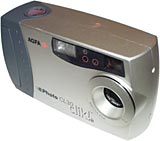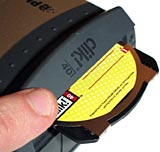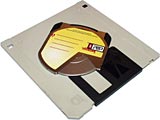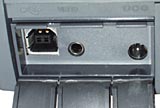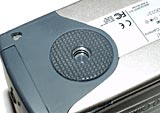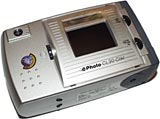
Agfa ePhoto CL30 Clik! digital still camera
Review date: 20 June 2000.Last modified 03-Dec-2011.
Want a medium-priced digital camera with storage that only costs 50 cents a megabyte? Sounds good, doesn't it? Is it, though?
Agfa's $AU1300 (US list price $US499) ePhoto CL30 Clik! digital camera has the shape, size and heft of a plain 35mm box-camera. Which means it's not especially awkward to use, but it's no ergonomic masterpiece, either.
At a glance, it looks like any number of rather cheaper digital cameras. But it's got one feature that makes it rather special, and neatly solves one of the Big Problems Of Digital Cameras.
Big Problem One with digital cameras, and a problem that the CL30 Clik! certainly doesn't solve, is price. If you're willing to forego the advantages of digital - instant results, easy reviewing, zero cost-per-shot - you can get some very capable film-camera gear for the price of even a basic digital.
Digitals are also not very sensitive - like a film camera loaded with "slow" film, digitals need a lot of light, or long exposure times, to get good pictures. And the CL30's no exception; its small-aperture lens doesn't let a lot of light in, although it does give the camera decent depth of field, which allows its peculiar click-click-click autofocus system to consistently take decently sharp pictures.
Want another problem? Delays. There's a small delay between when you press the shutter button and when a digital camera actually takes the picture. Generally speaking, the cheaper the digicam, the longer the delay.
And there's a bigger delay after you take a picture, as the image gets written to whatever storage the camera uses. Better digicams have memory buffers that let you stack up a few pictures before you have to wait for them to be saved, but cheap ones still don't, and the CL30 Clik! doesn't.
The problem the CL30 Clik! solves, and solves well, is storage space. Well, storage space per dollar, anyway. Digital camera storage media tend to be rather darn expensive, but this one's cheap and capacious, because it uses Iomega's clever little Clik! disks.
Here's the disk drive, in the end of the camera.
Most digital cameras use solid state storage - RAM chips, in a few different kinds of teeny little plastic package. The "flash RAM" used in digicam memory cards doesn't need backup power, and it's durable, but it's not cheap. The going rate is more than $AU5 per megabyte, for larger cards, and even more for lower capacity ones.
You can pay $AU139 for a 10Mb CompactFlash card, while a 64Mb one's only $AU290.
CompactFlash cards, Solid State Floppy Disk Card (SSFDC, also known as "SmartMedia") and Sony's Memory Stick all cost roughly the same per megabyte for cards of a given size. Digicams usually come with a not-very-big card, so many buyers find themselves adding a couple of hundred bucks to the purchase price to get a decent amount of storage.
Now, if you don't need a lot of storage in your camera, this isn't a big deal. If you're happy to use the camera's lower resolution/quality modes, or just operate near a computer onto which you can copy pictures as you take them, then you'll be fine with a relatively cheap card.
But if you do want enough carry-around storage for lots of high resolution pictures, a memory-card-based camera can suddenly become a much more expensive proposition. And a Clik! based camera becomes a rather more attractive one.
And at the moment, if you want a digital camera with a Clik! drive in it, you have the following options:
1) The Agfa ePhoto CL30 Clik!
Any questions?
Weeny disks
Clik! disks have a 40 megabyte capacity, but they're tiny - a 3.5 inch floppy disk looks huge next to one.
And, compared with memory cards, Clik! disks are practically free. You can get a 10-pack of them for less than $AU210. That comes to little more than 50 Australian cents per megabyte.
Well, 50 cents per pseudo-megabyte, anyway. Memory card makers, and Iomega as well, have picked up on the hard disk makers' habit of calling a megabyte 1,000,000 bytes. Because computers work in powers of two, a megabyte is actually two to the power of 20 bytes, or 1,048,576.
This means a "40 megabyte" Clik! disk really has about 38 megabytes of real capacity, once you convert from marketing-megabytes to real ones, and after you've formatted the disk, which takes up a little space.
For the same reason, a "48 megabyte" CompactFlash card (yours for $AU245) will only give you about 45.6 formatted megabytes. Poor saps who don't know this are right to feel cheated. But I digress.
The major problem with disk storage for portable devices has, traditionally, been that you can't get a decent amount of it into a small space without paying alarming amounts of money. Professional digital cameras have for some time come with teeny hard drives built in, but $AU15,000 is pretty much their starting price point, and they're still quite big and clunky.
At the other end of the spectrum, Sony have been selling tons of their floppy-disk-based Mavica-series digicams. The image quality's not fabulous, because the higher resolution floppy-cams use a lot of compression to fit a decent number of images on a disk. But the storage media are really cheap, and ubiquitous, and can be stuck straight in any computer to read the images back.
Sony's next step has been to put nothing less than an actual CD-R drive in their new MVC-CD1000 camera, slated to debut in the States in August this year for about $US1299. The CD1000 doesn't have a full 650Mb 120mm-disc drive - that would have made the camera more of a shoulder-mount gadget than a hand-held one.
Instead, it uses 80mm "CD single" sized CD-Rs, which can be read in almost any CD-ROM drive and store a respectable 156Mb of photos - not bad for well under $US3 a disc, when you buy a couple of dozen at once.
Of course, you can only write once to each CD-R, and the CD1000 costs rather more than twice as much as the CL30. So it's not really a competitor. In the $AU1000 to 2000 price bracket - which roughly correlates with the $US500 to $US1000 one - the Clik! drive would seem to be an excellent option.
And it is.
Unfortunately, the CL30 is not an excellent camera.
The awful truth
The CL30 Clik!'s specifications seem all right. 1440 by 1080 maximum resolution; various lower resolutions for when you want to fit more pictures on a disk; optical and LCD screen viewfinders; USB PC connectivity; a decent selection of manual settings - it seems to be in with a chance, in its price bracket.
In use, though, it's not nearly as good as it sounds.
For a start, that 1440 by 1080 resolution figure is, well, a lie.
The Agfa offers two high resolution image modes, plain "High" with 1152 by 864 resolution, and a special "PhotoGenie" mode, which is supposed to give you 1440 by 1080. That means this is a 1.5 megapixel camera, thoroughly deserving of the "MEGAPIXEL" stamped on the top of the thing, right?
Wrong.
The special PhotoGenie image format is just the maximum resolution again, but with less compression and a little extra bit in the JFIF header data that tells Agfa's image editing software - bundled with the camera - to interpolate in some extra image data.
The CL30 saves images to the Clik! disk as plain JPG (JFIF format) images, which you can load in any graphics program; the PhotoGenie pictures just have the extra header data, which is ignored by everything except Agfa's own software.
If the software were interpolating from raw CCD image data, and therefore perhaps doing more intelligent analysis of the image than the low-powered camera processor could, then I could believe that the interpolated images could actually look better than the plain high-res images the camera outputs. Digicams have done tricks like this before.
But PhotoGenie doesn't work that way. It's just a perfectly ordinary JPG file that you can load into any graphics program, which happens to have a little magic cookie in its header that tells Agfa's special software to make up some more pixels.
So you can use PhotoGenie mode - with or without Agfa's software - if you want less compression than the other high-res mode. It gives you that.
But don't think that this is really a megapixel-class camera. It's close - 1152 times 864 is 995,328 pixels - but it doesn't quite make it.
Plain high-res pictures from the CL30 are about 350 kilobytes in size. Agfa estimate that about 120 of 'em will fit on one Clik! disk, which seems close enough. PhotoGenie pictures are about 550 kilobytes, so Agfa's 60-per-Clik! figure seems OK as well.
There's also a 1024 by 768 medium-quality mode, and a 640 by 480 "Low" mode; they give you about 160 and 360 pictures per disk, respectively.
And there's an oddity, too - a black and white 1152 by 864 mode, meant for document photographs but acceptable for anything where a monochrome image is OK. It seems a bit more heavily compressed than the high quality colour modes, but it still looks fine, and weighs in at less than 180 kilobytes per image.
If there's not much detail in a picture - a person on a plain background, a night shot with a lot of black - then your image sizes will be smaller. And you can mix and match different image types as you like on the one disk.
But I doubt you'd want to use the lower res modes, once you'd seen them. Some digital cameras make obnoxious low-res pictures because they use tons and tons of compression, but compression is not the first thing you notice if you look closely at a Medium or Low mode picture from the CL30.
This is because the Agfa does a lousy job of scaling its CCD data down for lower resolution images.

Here's an example. This is a clip out of a PhotoGenie-quality shot of the picturesque skyline to one side of my office. It's lost a teeny bit of quality from the re-JPG-ing I used to get the image size down, but you've got to compare it very closely with the original to pick the difference.
The yellow colour cast is actually correct; the sun's setting behind me.

Now, here's the same thing in Medium quality mode. Look at the windows in the buildings. Nasty, eh?

And again, now from a Low quality image. Gak.

Here's the black-and-white version. The windows are back to normal, because the camera's back in full resolution mode.
This lower resolution quality loss problem is quite noticeable on all sorts of images. Diagonal lines go jaggy, fine detail becomes uneven. It's awful.
And I know why it's happening. The CL30's doing dumb nearest-neighbour scaling of a full-resolution image, when it's set to Medium or Low mode. It just throws away one pixel out of every nine for Medium, and four pixels out of every nine for Low. There is no easier way to scale an image, and there is no uglier way, either.
Every half-decent image resizing function these days uses at least bilinear interpolation - where a two-by-two neighbourhood area of the original image is examined to determine what colour each pixel in the scaled image should be.
Or, commonly, you get the superior bicubic interpolation algorithm, where a specially weighted four-by-four neighbourhood is used.
Bilinear and bicubic look quite similar for most scaling-down applications, and they both look much better than nearest-neighbour.
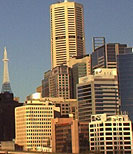

On the left, the same section of a PhotoGenie-quality image, scaled down using bicubic interpolation to the same size as it'd be if it were part of a 640 by 480 picture. On the right, the actual excerpt from the Low quality picture. If you can't pick the difference, then the CL30 is the camera for you.
The CL30's sensitivity isn't the best - a problem it shares with many other digicams. It also doesn't have any really long exposure times - the longest it can manage is 1/30 second. So it's not much use for dimly lit subjects.
You'll get recognisable happy snaps, without flash, of people in a normally lit room at night. The image will be a bit grainy and nasty, but not actually useless.
The CL30's flash is reasonably strong, but it's no use for distant targets. Night-time outdoor no-flash shots with the CL30 are ugly.
Software and connections
Along with Iomega's fancy Windows driver software, you get Agfa's own PhotoWise image organising-and-editing package. It's another product from the Roll Your Own School Of Interface Design, but it's quite capable and better than the pack-in software with many cheap digicams. And it understands the PhotoGenie format.
Checking out your images on a PC is preferable to using the not-very-sharp LCD screen on the camera, and its somewhat sluggish user interface.
Selecting images and options on the CL30's done with a scroll wheel control (Agfa call it an "EasyPilot Button") to the left of the LCD screen. You press the scroll wheel to enter setup mode, scroll to the menu you want, press again to select that menu, scroll to the option you want, and press to select the option. As cheap controllers go, this one's not too bad, although it's easy to overshoot the option you want.
The CL30 has springy rubber covers for its three side connectors - AC adaptor, USB cable and video out. There's no serial connection, and good riddance to it; serial may work with just about any computer in existence, but it's achingly slow. USB gives you a good chunk of a megabyte per second of transfer speed, versus little more than ten kilobytes per second for serial, with a following wind.
USB also lets you treat the camera like a removable drive, without installing anything beyond a simple driver. Plug the camera in and your PC thinks it's got a simple Clik! drive connected; unplug it and the drive disappears, with no rebooting or fooling around.
Viewfinding
As with all low-end digicams these days, the CL30 has a coaxial viewfinder, which doesn't look through the actual photo-taking lens and so doesn't quite show you what that lens is seeing, though the difference is negligible for long shots.
The closer you are to your subject, the more wrong a coaxial viewfinder will be; in these situations, you should use the LCD screen to preview the shot. The LCD has a rather slow refresh, especially for night-time indoor shots, and you get all kinds of weird colourful smear-and-blur effects when the scene's changing. It's useable, just, but I've seen much better; moving subjects are a real pain when you're using LCD preview.
Lens limitations
Sony have been putting really good high-powered zoom lenses in their Mavicas, which is a big plus compared with the unexciting 2X and 3X zoom you get from pretty much every other mid-range digital camera. But even 2X would be welcome in the CL30. It's got no optical zoom at all.
The small-aperture lens is a 43mm equivalent (which means it gives you the same field of view as a 43mm lens on a 35mm camera), giving it a reasonable field of view, but if you want to make a subject bigger - well, walk forward.
You do get some kind of zoom from the CL30, but it's only "2X digital zoom". The camera just crops out the middle bit of the image and saves it as a 640 by 480 image; you can do the same thing by taking a full-resolution shot and cropping it yourself. The "zoomed" pictures at least save some space, although they don't use the same high compression as the regular Low mode.
Cycle time
Cycle time is the length of time it takes, after taking a shot, before a digital camera's ready to take another one. It includes autofocus time, but it's mostly determined by the length of time the camera takes to compress and save images.
At P-Genie quality, there's roughly a 12 second delay between pressing the shutter button and being able to take another picture. High quality is 11 seconds, Medium and the black and white Text mode are 9.5, Low is 6.5. You can get digicams that cost less than the CL30 and include a RAM buffer, that holds a few images while they're compressed and saved and lets you shoot three or more pictures in quick succession before the real cycle time becomes an issue. The CL30 has no such feature, though.
Power
You don't get rechargeable batteries with the CL30, which is a bit cheeky on Agfa's part. Like many digitals, this gadget draws a lot of current from its four AA cells. It doesn't actually draw a huge amount of power, over time, but the peaks in the current graph are high, and non-rechargeable AA cells do not like this sort of load.
Nickel-cadmium (NiCd) or nickel metal hydride (NiMH) rechargeables are fine with high currents. They can deliver their full rated capacity when you're asking for more than an amp, no problem. On the other hand, they go flat much faster just sitting there doing nothing than will alkalines or the especially long-lived lithium cells. But that's a price you've got to pay with high power draw cameras like the CL30.
Ask for more than an amp from alkaline cells and the per-cell voltage drops dramatically, resulting in the cells seeming to be flat even when they've actually got quite a bit of capacity left, if only you give them a less demanding load.
Running from alkalines, the CL30 followed the usual digicam pattern; after only a few no-flash pictures on a fresh set of AA alkalines, the battery meter was already reading half-flat. And taking a mere 35 pictures, then hooking the camera up to a computer while it was still on battery power to transfer those images via USB to the PC, was enough to kill the AAs completely.
Now, you're meant to run the camera from the included AC adaptor whenever possible, to avoid this situation. And one of the cheesy switches to the right of the LCD lets you turn the LCD preview and review off, which helps a bit. But the image compression and disk drive suck a respectable amount of power, and alkalines still really aren't anything more than an emergency power source. Fortunately, you can pick up 1400mAh NiMH cells for less than $AU5 each, and a suitable charger's only $AU40 or so.
Other annoyances
The CL30 doesn't remember settings when you turn it off. Its default power-on settings are medium resolution, flash disabled. I hope you like 'em, because you get 'em every time you turn the camera on, no matter what you had set when you turned it off. Since medium resolution looks, as mentioned above, lousy, this is a pain.
There's a standard-thread tripod mount on the bottom of the CL30, which is a good thing. It's only made of plastic - so it wouldn't last if you were using it all day - but that's no big deal for most users.
Unfortunately, it's probably not deep enough for most tripod threads. It certainly wasn't deep enough for mine. Since the screw bottoms out before the tripod mount's properly attached, the camera will just flop around on top of the tripod. It'd need to be shimmed with a rubber washer, or something, to mount it properly.
Good stuff
The CL30's not all bad. You can unscrew the lens bezel, which has a plastic protector built into the bottom of its well. This gives you access to a standard 37mm screw thread, onto which you can attach filters or extra lenses; an add-on camcorder zoom lens will bring you closer to the action.
If you turn off autofocus, you can set the CL30 to focus at one, two or five metres, or infinity. With its small-aperture lens, this isn't a bad selection of options; it's got good depth of field, at the price of poor light gathering ability. There's also a macro-focus mode, which lets you take picture 10cm to 1m (four to 40 inches) from the lens. The macro mode works pretty well, for a cheap camera, but isn't very exciting for a more-than-$AU1000 one.
The back of the camera has a clear plastic guard over the LCD screen and the smaller status display above it. The guard'll save the LCDs from damage, but it's quite prominent, and will therefore collect scratches itself.
You get the usual collection of maybe-useful, maybe-not other features.
There's a ten second self-timer, and you can review multiple tiled images at once on the LCD screen, and you can assign images to different "albums" on the Clik! disk, and there's video out so you can show pictures on a TV or even record them on a VCR (PAL or NTSC), and there's a low-energy flash mode to activate external slave flashes (no hot shoe connector, though), and there's manual exposure tweaking to push the auto-exposure values one way or the other, and there's manual white balance setting to compensate for colour casts in the lighting.
But these are all just the things you expect from any half-decent digicam these days. Along with, for example, zoom, and useful low resolution modes.
Overall
In its high resolution modes, the CL30 delivers quite OK pictures.
But in every respect except its storage, the CL30's not very exciting. It is, essentially, an up-to-date entry-level digital camera that costs far too much, because of a funky storage system that's more appropriate for a much more serious camera.
While we wait for solid state storage to get cheaper, disk-in-camera systems are an excellent stopgap. And the Clik! drive is a perfectly good thing; it deserves success.
But for the same money as a CL30 Clik!, you can get rather better gear. Like, for instance, a Kodak DC280. The 280's a CompactFlash-storage camera which has all the same major features as the CL30, but (real) 1760 by 1168 resolution and 2X optical zoom. And 3X digital zoom, too, but never mind that.
The DC280, with a 20Mb CompactFlash card, is some $AU200 cheaper than the CL30 Clik!'s list price. For $AU1300, you could get another 32Mb card as well, which ought to take care of most people's storage problems.
The DC280's even got a RAM buffer to save three images in, so its cycle time for those first three pictures is less than four seconds; if you keep shooting as fast as you can, the cycle time then hops up to more than 20 seconds, but even a three-image buffer is enough to keep the cycle time in the background for most situations.
The DC280 isn't a pro-grade camera, but it's a much better one than the CL30 Clik!.
The CL30 Clik! is an entry level camera that might be able to cut it if it cost a lot less. But Clik! drives cost about $US150, and apparently don't cost any less when they're built into a camera. If tons of cheap storage is important to you, then a CL30 Clik! is clearly your best option. But if you actually want to take good pictures, and only being able to grab, say, 100 exposures before you have to dump some images is acceptable, then you should go for something else.
Pros: |
Cons: |
|
|
Review ePhoto CL30 Clik! kindly provided by Agfa Australia.
Buy digital cameras!
Readers from Australia or New Zealand can purchase
digital cameras from
Aus PC Market.
Click here!
(if you're NOT
from Australia or New Zealand, Aus PC Market
won't deliver to you. If you're in the USA,
try a price search at
DealTime!)
